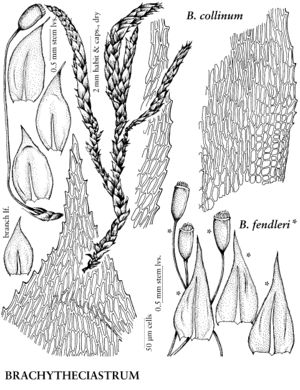Brachytheciastrum fendleri
Biodivers. Poland 3: 172. 2003.
Plants small, in loose to dense tufts, light green to yellowish or brownish. Stems 3–5 cm, creeping, terete-foliate, julaceous, irregularly pinnate, branches to 5 mm, terete-foliate. Stem-leaves erect-appressed when dry, erect-spreading when moist, loosely imbricate, straight, ovate or ovatelanceolate, not or sometimes slightly plicate, 0.9–1.3 × 0.2–0.5 mm; margins recurved basally, serrulate almost throughout; apex gradually tapered to sometimes acuminate, acumen spreading; costa to 60–70% leaf length, terminal spine present; alar cells subquadrate, 9–15 × 9–12 µm, region small, of 6–8 × 4 or 5 cells, distinctly to moderately delimited; laminal cells linear, 40–60 × 4–6 µm; basal-cells to 8–10 µm wide, indistinctly delimited from more distal cells. Sexual condition synoicous. Seta reddish, 1–1.5 cm, smooth or slightly rough. Capsule erect to inclined, reddish, ovate-elongate to cylindric, to 1.5 mm; endostome basal membrane less than 1/4 endostome length, cilia short to reduced or occasionally as long as segments. Spores 10–14 µm.
Habitat: Rock, soil over rock outcrops
Elevation: high elevations (1600-2400 m)
Distribution

Alta., Ariz., Calif., Colo., Mont., Nev., N.Mex., S.Dak., Tex., Utah, Wyo., Mexico (Chihuahua), Mexico (Durango)
Discussion
Brachytheciastrum fendleri, when treated within Brachythecium, was synonymized with B. collinum by A. J. Grout (1928–1940, vol. 3), and in some checklists, for example, M. F. V. Corley et al. (1981); this resulted in a broad extension of the species range. However, B. fendleri is confined to the southern part of United States and northern Mexico, and was recently discovered in the Canadian Rockies of Alberta (R. T. Caners, pers. comm.). The often erect and ovate-elongate to cylindric capsules and the synoicous inflorescence are evident in most collections, allowing easy separation from B. collinum. Important comments on the differentiation of these species were provided by K. D. McFarland (1994). The branch leaves are more falcate and less plicate than the stem leaves.
Selected References
None.
Lower Taxa
"long" is not a number."broad" is not a number.
